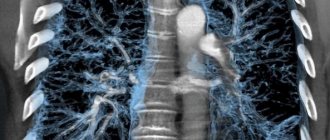When a woman registers with the antenatal clinic, the gynecologist prescribes many tests for her. It is also necessary to determine her blood type and Rh factor. Among the mandatory requirements is fluorography of the spouse. Many people are perplexed and wonder why such an examination is needed? What is its importance? Is it possible for a woman to undergo fluorography in the first trimester of pregnancy? Let's look into this issue.
Briefly about fluorography
This examination allows you to obtain complete information about the condition of the lungs and heart. That is why gynecologists, even at the stage of pregnancy planning, recommend that women undergo this along with other studies.
It is worth recalling that not so long ago pregnant women were strictly prohibited from undergoing fluorography. But today, many expectant mothers undergo this examination without complications or any consequences.
At its core, fluorography is an X-ray examination that allows you to clearly examine a shadow image of the lungs and heart, and determine abnormalities in them in the form of tumors, infectious foci, and structural changes. That is why therapists require their patients to undergo fluorography without fail. It is also needed as a component of medical examinations, commissions at military registration and enlistment offices and in other cases.
Surely everyone knows that in the process of conducting such diagnostics of the heart and lungs, the human body receives a certain dose of radiation. If he is healthy, then it is completely safe.
At conception, a new life is born in the female body, and the embryo is constantly growing and developing. Its cells are dividing. Exposure to X-rays can disrupt the development of the fetus. This is why fluorography is prohibited in the early stages of pregnancy, when the vital organs of the unborn child are being formed.
More on the topic
Is it possible to do fluorography during pregnancy?
Fluorography in early pregnancy
Fluorography when planning pregnancy
Is it possible to have an MRI during pregnancy?
How to determine the gender of the unborn child
What is fluorography?
Fluorography is a diagnostic procedure that allows for a detailed examination of the lungs, heart, pleural area, chest, mammary glands and spine. Essentially, this is the same X-ray, but the fluorograph emits less radiation, making the procedure safer.
The device photographs the chest on a fluorescent screen. The image is formed by passing X-rays through the human body, and they are unevenly absorbed by various organs and tissues. Currently, film fluorography has been replaced by a digital technique. Modern devices have become safer.
Previously, the procedure was strictly prohibited during pregnancy. Recently, if indicated, many pregnant women undergo fluorography without any consequences. The procedure is still prohibited in the first trimester, when the fetus develops organs.
About the dangers of fluorography during pregnancy
Sometimes it happens that a woman has to undergo such an examination without even realizing the “interesting situation”. If this happens in the first or second week of pregnancy, then there is no need to worry about it. At a very early stage, the embryo is quite reliably protected.
When such an examination was carried out from the third to the twentieth week of pregnancy, the woman should definitely see a geneticist. He will prescribe certain tests. Don't worry right away. It is not a fact that such a diagnostic procedure will lead to abnormal development of the fetus.
Most doctors are confident that expectant mothers can safely undergo fluorography if necessary, without fear of its negative impact on the baby. At this time, the risk of pathologies is minimized.
In addition, today you can undergo a digital examination. It exposes the female body to the least amount of radiation.
And during fluorography, a pregnant woman is protected by wearing a special lead apron: it protects the uterus from radiation, although everyone knows that this female organ is located below the lungs and does not fall under direct x-ray rays.
General indications for fluorographic examination
Indications for fluorographic examination:
- annual preventive examination for early detection of pathologies of the lungs and heart;
- admission to a higher or secondary specialized educational institution;
- employment in medical, educational, preschool institutions, as well as in the field of food and public transport;
- pregnancy planning;
- passing a medical examination for military service;
- visiting swimming pools and sports clubs;
- diagnosis of inflammatory processes of bacterial, fungal and viral origin (including tuberculosis and bronchitis);
- suspicion of tumors;
- study of structural changes in organ tissues;
- the presence of adhesions in the pleural area;
- monitoring the healing of chest injuries;
- examination of the husband during his wife's pregnancy.

Notes to the expectant mother
If you are planning a pregnancy, then you need to understand that fluorography will be a mandatory method of scanning the thoracic region. For this reason, you need to work with your doctor to select favorable days for diagnostic testing.
Modern equipment involves minimal radiation exposure and helps to quickly exclude or confirm pathological processes.
Fluorography is an integral part of preparation for conception; it detects dangerous diseases in a timely manner. However, during pregnancy the procedure should be avoided, but if absolutely necessary, diagnosis is possible at 20 weeks, when the adverse effects are minimal.
Why does the husband of a pregnant woman need fluorography?
Why does a man need fluorography, why do it? The answer suggests itself - to make sure of his health. Newborns are practically devoid of immunity; they are vaccinated against tuberculosis in the maternity hospital, but antibodies to the infection do not appear immediately. All family members must be healthy. Fluorography is the optimal method for diagnosing tuberculosis and other pulmonary infections in the early stages, when there are no characteristic symptoms yet.
Without fluorography, a man will not be allowed to attend the birth with his wife. By the way, without a certificate of fluorographic examination, the husband will not be allowed into the maternity hospital or into the ward with his wife and newborn baby. This rule applies not only to husbands, but to all family members.
Memo for future parents
When hospitalized in the maternity hospital, take with you:
Documentation:

E.O. Mukhina DZM" about the possibility of childbirth in the maternity hospital. • Paid agreement for the provision of primary health care services under obstetric care programs (for those who use such services). Items: • Bathrobe • Shirt • Washable slippers • Socks • Personal care items (personal hygiene) • Phone + charger • Mineral water (still)
Relatives present at the birth must have with them: • Passport • Fluorography or chest x-ray - no later than 6 months • A physician’s report on past coronavirus infection COVID-19, either a positive test for immunoglobulins G for the new coronavirus infection COVID-19, or negative the result of a study of biological material (nasal and oropharyngeal swab) for the presence of a new coronavirus infection COVID-19 using the PCR method, carried out no more than 7 days before the date of delivery or information about vaccination
• Clothes (clean cotton trousers, T-shirt, rubber slippers)
Answers to frequently asked questions:

Does the maternity hospital practice partner births and who can attend them? Yes. We welcome the presence of a loved one at the birth. This could be a husband, mother, sister.
What examination methods are required to be present at childbirth? Fluorography or chest x-ray - no later than 6 months. The conclusion of a general practitioner about the past coronavirus infection COVID-19 or a positive test for immunoglobulins G for the new coronavirus infection COVID-19, or a negative result of a study of biological material (nasal and oropharyngeal swab) for the presence of a new coronavirus infection COVID-19 using the PCR method no more than 7 days before the date of delivery or information about vaccination.
Is early attachment of a newborn to the mother's breast practiced in the maternity hospital? Yes, if the condition of the mother and child is satisfactory.
When is a newborn separated from its mother? Clamping of the umbilical cord during vaginal delivery is performed after the pulsation of the umbilical cord vessels has stopped (usually after 1-3 minutes).
Is vertical birth practiced? Yes it is possible.
Does everyone benefit from labor pain relief? Pain relief is given if necessary. Everything depends on the obstetric situation and is decided in each case

individually.
How to get to the maternity hospital? Planned hospitalization by referral from a doctor at the antenatal clinic, or emergency hospitalization for childbirth by ambulance, or by self-referral.
What are the conditions of stay in the maternity hospital? The actual birth takes place in individual boxes. In the postpartum department and the pregnancy pathology department there are 2-bed rooms with a bathroom.
What vaccinations are given to newborns? Vaccinations against hepatitis B and tuberculosis are given only with the written consent of the mother.
What milk formulas are used in the maternity hospital to feed babies? We recommend breastfeeding. But if problems arise, no one will go hungry. Adapted milk formulas are used strictly for medical reasons.
Is it possible to refuse the examination and is it necessary to do so?
Fluorography of the husband during pregnancy is, in principle, not necessary, but it is extremely unwise to refuse it. Firstly, he is responsible for the health of his wife and child, so he must be confident in his health. Secondly, the procedure is painless, practically harmless and takes little time. Any future father, even a very busy one, will be able to set aside time for the sake of his family.
Possible negative consequences for the mother in labor. Some medical institutions refuse to admit a woman without the appropriate certificate. They can also refer her to the prenatal infectious diseases department to reduce the possible risk for other women in labor and newborns.
Of course, a woman will not remain on the street to give birth, but troubles may arise. That is why it is easier to undergo the procedure and get the opportunity to see your child in the first minutes of his life.
Blood test for TORCH infections
TORCH infections are diseases that are most dangerous for the harmonious development of the fetus during all trimesters of pregnancy. These include: herpes, toxoplasmosis, rubella, cytomegalovirus.
Every woman who wants to get pregnant must take a blood test for the presence of these infections, but male clinical examinations are also not complete without it.
If IgG antibodies are detected in the blood, this will mean that some time ago the patient’s body was indeed affected by a TORCH infection, but managed to overcome it. If, as a result of the analysis, IgM antibodies are detected, then the situation will be significantly worse: the presence of such antibodies signals the presence of the disease in the acute phase. If IgM antibodies are detected in the bodies of the intended future parents, pregnancy must be postponed until recovery.








